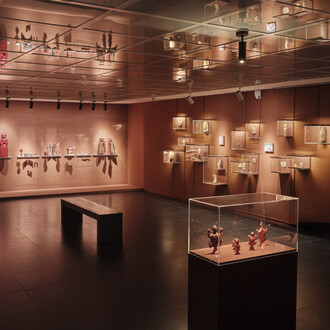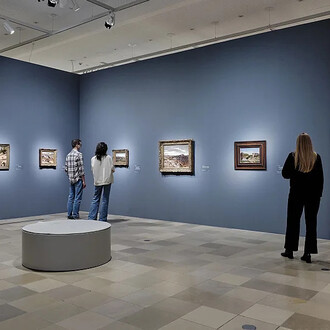Both Archives and Orbits hold fragments of knowledge, history, and the unseen forces that shape them. Just as a piece of rock can be a simple object or something more profound, the artist's studio often documents personal archives that form an intricate topography of lived experiences and material explorations. These are never fixed but spin a delicate dance where information and interpretation trace elliptical paths through time. What distinguishes an archive from a simple collection of things is the deliberate act of selection, arrangement, and preservation—the way we inscribe and map a constellation of things, ideas and forms before they fade. An archive is often a site where meaning is continually reinterpreted, dynamic yet haunted by what it does not contain. Not only a record of the past but also a tool for the future.
This exhibition brings together five artists who reflect very differently on ideas of order, preservation, memory and time. Through painting, sculpture and photographic works, this group exhibition shows that we are archivists and archives, moving in perpetual orbits, arranging fragments of experience, leaving deliberate traces and erasing others.
Katja Davar is exhibiting works from the series To perch. This series looks at the migratory movement of birds around world through landscapes defined by geographical and cultural boundaries. She engages with the visual language of technological and natural systems showing unfamiliar yet referential worlds through new spherical drawings. The two hanging globes display the entanglement of organic and synthetic systems drawn from diverse visual sources.
Flo Maak presents a series of new assemblages titled naturalscenerycrop alongside photographs that explore the entanglement of human-made structures and objects with the natural environment. The assemblages are based on pictures of geological structures, mostly of volcanic origin. The choice of linen as a material, references both traditional displays in natural history museums and the Western tradition of knowledge preservation. Linen-covered wooden strips frame the motifs, drawing focus to the acts of framing, cropping, and appropriating landscape through photography.
Christa Näher is showing a self-portrait from 2022 titled 1947, her birth year. This work is a complex painting that has been reworked multiple times. Näher’s work often deals with themes of human existence through depictions of creatures and childhood fears that have accompanied her since her birth. As a child, Näher was familiar with many of the creatures that she paints and, similar to Pier Paolo Pasolini, she exposes and dissects the fear that she experienced in her work. 1947 is a portrait of her birth and is a unique work in Näher’s oeuvre, a nod and a reflection on her personal archive.
Sonya Schönberger explores memory, history, and the impact of historical events on individuals and society. Using interviews, archives, and found materials, she examines personal and collective narratives. Sonya Schönberger’s sculpture Dismissed, comprises of several hundred keys sourced from a former National People's Army (NVA) and People's Police barrack in Brandenburg. Her work Weißenfels, is a series of photographs of entrances and shop windows in the city of Weißenfels that are closed and abandoned. They show remnants of a state that no longer exists, the GDR, and provoke questions about what to remember and what to discard.
Christoph Westermeier is showing new works from the series Die pappel im wind. This work series focuses on Ernst Heimrath (1905–1945) an actor and dancer largely forgotten by theatre history. Heimrath struggled as an extra before creating and photographing his own choreographies. Christoph Westermeier explores Heimrath’s life through archival fragments, blending text and photography in a media-critical film collage. The work offers insight into a non-conforming life in the early 20th century.
















